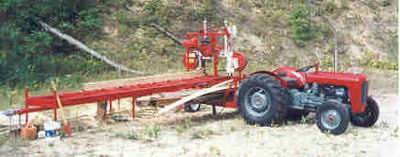Leveling your mill
Other Versions
Spanish
Instruments and methods for ensuring your sawmill is level when you set it up. November 18, 2002
Question
What different methods are being used to level mill beds? I use a 4' level, string and spacer blocks. Anyone use a laser level?
Here is my mill setup:

Forum Responses
I use an 8' level.
I also used a 4' level, string and spacer blocks.
Wood-Mizer mills are generally leveled plenty close by eye - a few degrees one way or the other does not affect them. When we set up our mill for stationary sawing, I just used a 4' carpenter's level because that was what I had.
I use a 2 foot level that I keep with my other tools for the
Wood-Mizer, but it doesn't have to be perfect. In fact, I like downhill towards stops and towards the end.
That's the great thing about a mill with a rigid frame. It is already straight. All you have to do is get it reasonably level so it doesn't hurt itself. Is
Wood-Mizer the only mill out there with a rigid frame?
I have a Baker 18HD. The frame is straight and very sturdy. As a carpenter, I believe that a string line and block is a very accurate way to check for straightness. However, a four foot or even an eight foot level can still put the mill off an inch or two over the length of the mill. My mill is fully manual, so I like to have it tilted downhill just a bit in the sawing direction.
With a Lumbermate we use only a 4' level. We perform a string check every year to make sure framework is straight. Leveling helps head travel and lowers vibration.
From contributor K:
When calibrating the surface of your bed, using a 4' level is a good tool. However, a 4' level will not show a camber or twist in your bed. However slight they may be, they will affect the final quality of your lumber. If there is even a slight twist in your bed, as the carriage travels over that twist, you will be sawing that twist in your cant. Then, when you turn your cant 180 degrees, that twist is compounded to the other side of the cant. This will give you uneven lumber, and you may tear your hair out trying to figure out why. A camber will do basically the same thing. The best tool to use is a transit if your bed is 18' or longer to make sure your setup is correct. We hold our bed tolerance to +/- .060" all around. We then check the location of the blade to the bed at every cross member to maintain consistency. You may also have bridging rods under your bed. By tightening or loosening them, they will cause or cure camber and twist as well. A flat bed makes a big difference!
How often do you recheck the bed for level? I'd think the first log you load and saw will cause the mill to settle unless you are on very firm ground or use a lot of footing material.
I know on my Wood-Mizer, after running it a while after initial setup, I'd go around and kick the leg supports with my toe to see if any are floating. If so, I'd pull it up and stick another shim under the plate. Even with a leg or two without pressure on them, the mill would still cut true. But with a support or two without contact, the mill would tend to scoot around some when logs were loaded or turned - not being nearly as heavy as other mills.
From contributor K:
I will recheck the bed as soon as I see something wrong with the lumber. You can often tell that something is wrong if your cant is not laying flat on all cross members or is not up tight to all head blocks. As long as your cants are lying correct and your lumber is square and true, you should be in good shape.
I have a two track mill that I set on the ground. I use a 4 foot level to measure across the track. To get maximum accuracy, made sure that you keep the level the same side up and pointing in the same direction, then level so the bubble is in the same position. A string will always have a bow in it, so don't rely on it to level front to back. I sight along the log rest and shim under the track. I have a 12 foot 2x4 steel tubing that I put on the log rest to check for final leveling.
I have an Enercraft (now Baker) Mill, my second. The first one was perfectly straight. This one has a slight round in the bed. It is not bad up to 12 foot, but for 16 foot stuff it drives me nuts. The bed is so sturdy that it will have to stay like that. I live too far out in the boonies to get it repaired. Hopefully my next one will be better.
